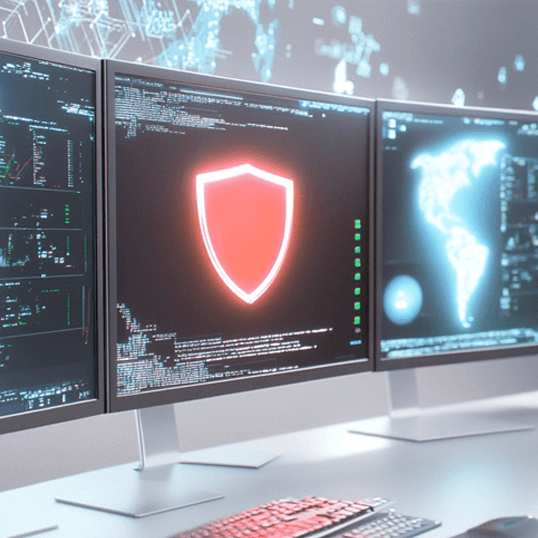Introduction to MXDR
Managed Extended Detection and Response (MXDR) stands out as a critical solution for protecting organizations against sophisticated cyber threats. MXDR builds upon the capabilities of Managed Detection and Response (MDR), extending its reach to encompass a broader range of security measures across various environments, including endpoints, networks, and cloud services.
What is MXDR?
MXDR is a next-generation security solution that combines advanced detection and response capabilities with continuous monitoring and real-time threat intelligence. The “X” in MXDR signifies its ability to extend beyond traditional security measures, offering a comprehensive approach to threat detection and response. This service integrates seamlessly with an organization’s existing security infrastructure, providing enhanced visibility and faster response times.
Importance of MXDR in Modern Cybersecurity
The modern threat landscape is characterized by an increase in sophisticated cyber-attacks, targeting various vectors such as endpoints, networks, and cloud environments. Traditional security measures often fall short in addressing these complex threats, leaving organizations vulnerable. MXDR addresses this gap by providing a holistic security solution that continuously monitors and responds to threats in real-time, ensuring that organizations maintain a robust security posture.
Key Features of MXDR
- Continuous Monitoring: MXDR services provide 24/7 monitoring of an organization’s IT environment, ensuring that potential threats are detected and mitigated promptly.
- Advanced Threat Intelligence: By integrating real-time threat intelligence, MXDR solutions can identify and respond to emerging threats more effectively.
- Automated Response and Remediation: Automation in MXDR allows for swift response to detected threats, minimizing the impact of incidents and reducing the time to remediation.
- Scalability and Flexibility: MXDR solutions are designed to scale with the organization’s needs, providing flexible security measures that can adapt to changing threat landscapes.
Why Organizations Need MXDR
As cyber threats continue to evolve, the need for advanced security solutions like MXDR becomes increasingly important. Organizations face challenges such as a shortage of skilled cybersecurity professionals, the complexity of managing multiple security tools, and the constant pressure to protect sensitive data from breaches. MXDR addresses these challenges by offering a managed service that combines human expertise with advanced technology, providing comprehensive protection and allowing internal teams to focus on core business activities.
Conclusion
In conclusion, MXDR represents a significant advancement in cybersecurity, offering organizations a robust and comprehensive solution for threat detection and response. By integrating continuous monitoring, real-time threat intelligence, and automated response capabilities, MXDR ensures that organizations can stay ahead of emerging threats and maintain a strong security posture. As cyber-attacks become more sophisticated, adopting MXDR solutions will be crucial for organizations looking to protect their assets and ensure business continuity.
The Evolution of Cybersecurity: From EDR to MXDR
As cyber threats continue to evolve, so too must the strategies and technologies used to combat them. The journey from Endpoint Detection and Response (EDR) to Managed Extended Detection and Response (MXDR) represents a significant advancement in cybersecurity, providing organizations with more comprehensive and effective protection against a wide range of threats.
The Role of EDR in Cybersecurity
Endpoint Detection and Response (EDR) emerged as a critical tool in the fight against cyber threats, focusing specifically on endpoint devices such as laptops, desktops, and mobile devices. EDR solutions monitor these endpoints in real-time, collecting and analyzing data to detect suspicious activities. When a threat is identified, EDR systems can respond quickly, isolating affected devices, removing malicious files, and restoring compromised systems to a secure state.
Key features of EDR include:
- Continuous Monitoring: Real-time surveillance of endpoint activities to detect and respond to threats immediately.
- Data Collection and Analysis: Aggregation of data from endpoints to identify patterns and anomalies indicative of cyber threats.
- Automated Response: Swift action to mitigate threats, such as quarantining infected devices and deleting malware.
While EDR provided a solid foundation for endpoint security, it became clear that focusing solely on endpoints was not enough to combat increasingly sophisticated cyber-attacks.
The Emergence of MDR
Managed Detection and Response (MDR) expanded upon the principles of EDR by incorporating managed services. MDR providers offered not just the technology but also the expertise needed to monitor, detect, and respond to threats on behalf of organizations. This approach leveraged the skills of cybersecurity professionals, advanced analytics, and threat intelligence to enhance an organization’s security posture.
MDR introduced several advancements:
- Human Expertise: Utilization of skilled security analysts to interpret data, identify threats, and respond to incidents.
- Comprehensive Monitoring: Extending beyond endpoints to include network and server monitoring.
- Proactive Threat Hunting: Actively searching for threats rather than waiting for alerts.
MDR represented a significant improvement over EDR by providing a more comprehensive and proactive approach to threat detection and response. However, the increasing complexity and diversity of cyber threats demanded an even more extensive solution.
Advancing to MXDR
Managed Extended Detection and Response (MXDR) represents the next evolution in cybersecurity, extending the capabilities of MDR to cover the entire attack surface. MXDR integrates multiple security layers, providing holistic protection across endpoints, networks, cloud environments, and more.
Key enhancements of MXDR include:
- Holistic Visibility: Comprehensive monitoring of all aspects of the IT environment, including endpoints, networks, cloud services, and IoT devices.
- Advanced Threat Intelligence: Integration of real-time threat intelligence to enhance the detection of emerging threats.
- Automated and Orchestrated Response: Automation of response actions to reduce the time to remediation and improve efficiency.
- Unified Security Operations Center (SOC): Centralized management and coordination of security efforts through a dedicated SOC.
Comparing EDR, MDR, and MXDR
| Feature | EDR | MDR | MXDR |
|---|---|---|---|
| Scope | Endpoints only | Endpoints, networks, and servers | Endpoints, networks, cloud services, IoT devices |
| Monitoring | Continuous endpoint monitoring | Comprehensive monitoring by security experts | Holistic visibility across the entire attack surface |
| Threat Intelligence | Basic threat data | Advanced analytics and threat intelligence | Real-time integration of global threat intelligence |
| Response | Automated endpoint response | Human-led incident response | Automated and orchestrated response |
| Expertise | Relies on in-house teams | Managed service with expert analysts | Managed service with advanced, unified SOC |
Conclusion
The evolution from EDR to MXDR highlights the growing complexity of the cybersecurity landscape and the need for more comprehensive solutions. While EDR laid the groundwork for endpoint security, MDR expanded this by incorporating human expertise and broader monitoring capabilities. MXDR takes this evolution further, providing a unified, comprehensive approach to threat detection and response that covers the entire attack surface. As cyber threats continue to grow in sophistication, organizations must adopt advanced solutions like MXDR to stay ahead of potential attacks and ensure robust protection for their assets.
Core Components of MXDR
Managed Extended Detection and Response (MXDR) represents a comprehensive approach to cybersecurity, integrating advanced detection and response capabilities across an organization’s entire IT environment. Understanding the core components of MXDR is essential for appreciating how this solution enhances security and mitigates threats effectively.
Continuous Monitoring
Continuous monitoring is a fundamental aspect of MXDR, ensuring that all potential threats are detected and addressed in real-time. This 24/7 vigilance allows organizations to maintain a robust security posture by identifying and responding to threats as they arise.
Key features of continuous monitoring include:
- Real-time Surveillance: Constant observation of network traffic, endpoint activities, and cloud environments to detect anomalies and suspicious behavior.
- Comprehensive Data Collection: Aggregation of data from various sources, including endpoints, networks, cloud services, and IoT devices, to provide a holistic view of the security landscape.
- Alerting and Notification: Immediate alerts and notifications when potential threats are detected, enabling swift response and mitigation.
Threat Intelligence Integration
Integrating threat intelligence into MXDR enhances the ability to detect and respond to emerging threats. Threat intelligence involves collecting, analyzing, and sharing information about current and potential threats, allowing security teams to stay ahead of cyber adversaries.
Benefits of threat intelligence integration:
- Enhanced Detection: Leveraging up-to-date threat intelligence to identify and respond to threats more accurately and quickly.
- Proactive Defense: Anticipating and mitigating threats before they can impact the organization by understanding the tactics, techniques, and procedures (TTPs) used by attackers.
- Contextual Awareness: Providing context to security alerts, which helps in prioritizing and responding to threats more effectively.
Automated Response and Remediation
Automation plays a crucial role in MXDR, enabling rapid response to detected threats and minimizing the impact on the organization. Automated response and remediation ensure that threats are addressed swiftly and efficiently, reducing the time to resolution and freeing up security personnel to focus on more complex tasks.
Key aspects of automated response and remediation:
- Incident Isolation: Automatically isolating affected systems to prevent the spread of malware or unauthorized access.
- Threat Neutralization: Removing malicious files, terminating suspicious processes, and applying security patches automatically.
- Restoration: Restoring compromised systems to their pre-attack state, ensuring business continuity and minimizing downtime.
Advanced Analytics and Machine Learning
MXDR leverages advanced analytics and machine learning to enhance threat detection and response capabilities. These technologies analyze vast amounts of data to identify patterns and anomalies that may indicate a security threat.
Features of advanced analytics and machine learning:
- Behavioral Analysis: Monitoring and analyzing user and entity behavior to detect deviations from normal patterns that may indicate a threat.
- Anomaly Detection: Identifying unusual activities that could signify a security breach, such as unusual login times or access patterns.
- Predictive Analytics: Using historical data to predict potential threats and vulnerabilities, enabling proactive defense measures.
Unified Security Operations Center (SOC)
A unified Security Operations Center (SOC) is the nerve center of MXDR, providing centralized management and coordination of all security activities. The SOC integrates various security tools and processes, ensuring seamless operation and effective threat management.
Key functions of the SOC:
- Centralized Monitoring: Continuous surveillance of the entire IT environment from a single location, providing a comprehensive view of the organization’s security posture.
- Incident Management: Coordinating response efforts to ensure timely and effective mitigation of security incidents.
- Collaboration and Communication: Facilitating communication between security teams, IT personnel, and other stakeholders to ensure a cohesive and coordinated response to threats.
Scalability and Flexibility
MXDR solutions are designed to scale with the needs of the organization, providing flexible security measures that can adapt to changing threat landscapes and business requirements.
Benefits of scalability and flexibility:
- Customizable Solutions: Tailoring MXDR services to meet the specific needs and requirements of the organization, whether it is a small business or a large enterprise.
- Dynamic Scaling: Adjusting the level of monitoring and response capabilities based on the organization’s growth and evolving threat landscape.
- Integration with Existing Tools: Seamlessly integrating with the organization’s existing security infrastructure, enhancing overall effectiveness without requiring a complete overhaul.
Conclusion
The core components of MXDR—continuous monitoring, threat intelligence integration, automated response and remediation, advanced analytics and machine learning, unified SOC, and scalability and flexibility—work together to provide comprehensive protection against cyber threats. By understanding and leveraging these components, organizations can enhance their security posture, respond more effectively to threats, and ensure business continuity in the face of evolving cyber challenges.
Key Benefits of MXDR Solutions
Managed Extended Detection and Response (MXDR) solutions offer a multitude of benefits that significantly enhance an organization’s cybersecurity posture. By integrating advanced technologies with expert human oversight, MXDR provides comprehensive protection against a wide range of cyber threats. Here are the key benefits of implementing MXDR solutions:
Improved Threat Detection and Response
One of the most significant advantages of MXDR is its ability to improve threat detection and response capabilities. By leveraging continuous monitoring, advanced analytics, and real-time threat intelligence, MXDR solutions can identify and respond to threats more quickly and accurately than traditional security measures.
- Enhanced Detection: MXDR utilizes sophisticated algorithms and machine learning to analyze vast amounts of data and identify patterns indicative of cyber threats. This ensures that even the most subtle indicators of compromise are detected.
- Faster Response Times: With automated response capabilities, MXDR solutions can quickly isolate affected systems, remove malicious files, and apply security patches, significantly reducing the mean time to respond (MTTR).
- Proactive Threat Hunting: MXDR includes proactive threat hunting activities that search for hidden threats within the network, ensuring that potential issues are addressed before they can escalate into significant incidents.
Enhanced Security Posture
Implementing MXDR can dramatically enhance an organization’s overall security posture. By providing continuous, real-time monitoring and a comprehensive view of the entire IT environment, MXDR ensures that security teams are always aware of the latest threats and vulnerabilities.
- Comprehensive Visibility: MXDR offers holistic visibility across endpoints, networks, cloud services, and IoT devices, enabling security teams to monitor and protect all aspects of the IT infrastructure.
- Integrated Security Measures: MXDR integrates various security tools and technologies, creating a unified approach to threat detection and response. This integration enhances the effectiveness of security measures and reduces the likelihood of security gaps.
- Adaptive Security: MXDR solutions are designed to adapt to the evolving threat landscape, ensuring that organizations are protected against the latest cyber threats.
Reduction in False Positives
False positives can be a significant drain on security resources, leading to alert fatigue and potentially causing genuine threats to be overlooked. MXDR solutions employ advanced analytics and machine learning to reduce the number of false positives, allowing security teams to focus on real threats.
- Sophisticated Filtering: MXDR systems use advanced filtering techniques to distinguish between benign events and actual threats, minimizing the number of false alerts.
- Contextual Analysis: By providing context to security alerts, MXDR helps security teams understand the nature and severity of potential threats, reducing the time spent investigating false positives.
- Improved Accuracy: The use of machine learning and behavioral analysis improves the accuracy of threat detection, ensuring that genuine threats are identified and addressed promptly.
Cost Efficiency
While cybersecurity is a critical investment, organizations must also consider cost efficiency. MXDR solutions can be more cost-effective than maintaining an extensive in-house security team and infrastructure.
- Lower Total Cost of Ownership: MXDR offers a managed service model, reducing the need for significant capital investment in security tools and technologies. This model often leads to a lower total cost of ownership compared to building and maintaining an in-house security infrastructure.
- Shared Resources: By leveraging the expertise and resources of the MXDR provider, organizations can benefit from advanced security capabilities without the need to hire and train additional staff.
- Operational Savings: MXDR automates many routine security tasks, freeing up internal IT and security teams to focus on core business activities, leading to operational savings.
Resource Optimization
The cybersecurity skills gap is a well-documented challenge, with many organizations struggling to attract and retain qualified security professionals. MXDR helps address this issue by providing access to a team of experts who can manage the organization’s security needs.
- Expertise on Demand: MXDR providers offer access to a team of experienced security analysts and threat hunters who can augment the organization’s existing security capabilities.
- Focus on Core Activities: By outsourcing security monitoring and response tasks to an MXDR provider, internal teams can focus on strategic initiatives and critical business objectives.
- Continuous Improvement: MXDR solutions often include continuous improvement programs that help organizations stay ahead of emerging threats and maintain a robust security posture.
Improved Threat Intelligence
Integrating threat intelligence into MXDR solutions enhances the ability to detect and respond to emerging threats. Threat intelligence provides valuable insights into the tactics, techniques, and procedures (TTPs) used by cyber adversaries, enabling organizations to stay ahead of potential attacks.
- Real-time Updates: MXDR solutions continuously update their threat intelligence databases, ensuring that security teams have access to the latest information on emerging threats.
- Informed Decision-making: Threat intelligence enables security teams to make data-driven decisions, improving the effectiveness of their response efforts.
- Proactive Defense: By understanding the TTPs used by attackers, MXDR solutions can proactively defend against potential threats, reducing the risk of successful attacks.
Conclusion
The key benefits of MXDR solutions—improved threat detection and response, enhanced security posture, reduction in false positives, cost efficiency, resource optimization, and improved threat intelligence—demonstrate the significant value that MXDR brings to an organization’s cybersecurity strategy. By integrating advanced technologies with expert human oversight, MXDR provides comprehensive protection against a wide range of cyber threats, ensuring that organizations can maintain a robust and resilient security posture in an increasingly complex threat landscape.
Implementing MXDR in Your Organization
Implementing Managed Extended Detection and Response (MXDR) in your organization involves several strategic steps to ensure successful integration and maximize the benefits of this advanced security solution. From assessing your security needs to choosing the right provider and ensuring seamless integration, each step is crucial for enhancing your cybersecurity posture.
Assessing Your Security Needs
Before implementing MXDR, it is essential to conduct a thorough assessment of your organization’s current security posture and identify specific needs and vulnerabilities. This assessment will help you determine the scope of the MXDR solution required and ensure that it aligns with your security objectives.
- Security Posture Evaluation: Review your existing security measures, tools, and processes to identify gaps and areas for improvement.
- Risk Assessment: Conduct a comprehensive risk assessment to identify potential threats and vulnerabilities specific to your organization’s IT environment.
- Security Objectives: Define clear security objectives and goals that you aim to achieve with the implementation of MXDR.
Choosing the Right MXDR Provider
Selecting the appropriate MXDR provider is a critical step in the implementation process. The right provider should offer a solution that aligns with your organization’s security needs, budget, and existing infrastructure.
- Expertise and Experience: Choose a provider with a proven track record in delivering MXDR solutions and a deep understanding of the cybersecurity landscape.
- Technology Stack: Ensure that the provider uses advanced technologies and tools that can integrate seamlessly with your existing security infrastructure.
- Service Level Agreements (SLAs): Review the provider’s SLAs to understand their commitment to response times, service availability, and performance metrics.
- Customer Support: Evaluate the provider’s customer support capabilities, including availability of support staff, response times, and escalation procedures.
Integration and Deployment
The successful deployment of MXDR requires careful planning and execution to minimize disruption and ensure seamless integration with your existing security infrastructure.
- Planning and Preparation: Develop a detailed implementation plan that outlines the steps required for deployment, including timelines, resource allocation, and potential risks.
- Configuration and Setup: Work with the MXDR provider to configure the solution to meet your organization’s specific needs. This may involve setting up monitoring and alerting rules, integrating with existing security tools, and customizing dashboards and reports.
- Testing and Validation: Conduct thorough testing to validate that the MXDR solution is functioning as expected. This includes testing detection and response capabilities, as well as ensuring that all integrations are working correctly.
- Training and Onboarding: Provide training for your internal security teams to familiarize them with the MXDR solution and ensure they understand how to use it effectively.
Continuous Improvement and Optimization
Implementing MXDR is not a one-time event but an ongoing process that requires continuous improvement and optimization to adapt to the evolving threat landscape.
- Regular Assessments: Conduct regular assessments of your MXDR solution to identify areas for improvement and ensure it remains aligned with your security objectives.
- Updates and Upgrades: Keep the MXDR solution up to date with the latest threat intelligence, software updates, and security patches.
- Feedback Loop: Establish a feedback loop with your MXDR provider to share insights, discuss challenges, and collaborate on enhancements to the solution.
- Performance Monitoring: Continuously monitor the performance of the MXDR solution, including detection and response times, false positive rates, and overall effectiveness.
Conclusion
Implementing MXDR in your organization involves a strategic approach that includes assessing your security needs, choosing the right provider, ensuring seamless integration, and continuously optimizing the solution. By following these steps, you can enhance your cybersecurity posture, protect against advanced threats, and ensure business continuity. MXDR offers a comprehensive and scalable solution that adapts to your organization’s evolving security needs, providing robust protection in an increasingly complex threat landscape.
Comparing MXDR Providers
When selecting a Managed Extended Detection and Response (MXDR) provider, it is crucial to understand the unique features and capabilities that different providers offer. This section will highlight key factors to consider and compare various MXDR providers based on essential criteria to help you make an informed decision.
Key Factors To Consider when Comparing MXDR Providers
Choosing the right MXDR provider involves evaluating several critical factors to ensure the solution meets your organization’s specific needs. Here are some of the key factors to consider:
- Expertise and Experience: The provider’s experience in delivering MXDR solutions and their understanding of the cybersecurity landscape.
- Technology and Tools: The advanced technologies and tools used by the provider to detect, monitor, and respond to threats.
- Integration Capabilities: The provider’s ability to seamlessly integrate with your existing security infrastructure and tools.
- Service Level Agreements (SLAs): The provider’s commitment to response times, service availability, and performance metrics.
- Customer Support: The availability and quality of customer support, including response times and escalation procedures.
- Cost and Value: The overall cost of the MXDR solution and the value it provides in terms of enhanced security and risk reduction.
Here are some of the features and capabilities offered by various leading MXDR providers:
- Continuous Monitoring and Real-time Detection:
- 24/7 monitoring of endpoints, networks, and cloud environments.
- Real-time detection of threats using advanced analytics and machine learning.
- Proactive threat hunting and incident response capabilities.
- Threat Intelligence Integration:
- Integration of real-time threat intelligence to enhance detection and response.
- Access to global threat intelligence feeds and databases.
- Continuous updates to threat intelligence to stay ahead of emerging threats.
- Automated Response and Remediation:
- Automated incident response to isolate affected systems and remove threats.
- Swift remediation actions to restore compromised systems to a secure state.
- Orchestrated response to minimize the impact of security incidents.
- Unified Security Operations Center (SOC):
- Centralized management of security activities through a dedicated SOC.
- Coordination of response efforts to ensure timely and effective mitigation of threats.
- Collaboration between security teams and stakeholders to enhance threat management.
- Advanced Analytics and Machine Learning:
- Use of behavioral analysis to detect deviations from normal patterns.
- Anomaly detection to identify unusual activities indicative of security threats.
- Predictive analytics to anticipate potential threats and vulnerabilities.
- Scalability and Flexibility:
- Solutions designed to scale with the organization’s growth and evolving security needs.
- Customizable services tailored to meet specific security requirements.
- Dynamic scaling of monitoring and response capabilities based on threat landscape.
- Customer Support and Service:
- Availability of 24/7 customer support and technical assistance.
- Dedicated account managers and support staff to address customer needs.
- Comprehensive onboarding and training for internal security teams.
Selecting the right MXDR provider is crucial for enhancing your organization’s cybersecurity posture. By considering factors such as expertise, technology, integration capabilities, SLAs, customer support, and cost, you can make an informed decision that aligns with your security needs. Comparing the features and capabilities of different providers helps ensure that you choose an MXDR solution that offers comprehensive protection, scalability, and value for your organization. With the right MXDR provider, you can effectively detect, respond to, and mitigate cyber threats, ensuring the security and resilience of your IT environment.
Conclusion
The implementation of Managed Extended Detection and Response (MXDR) represents a significant advancement in cybersecurity, providing organizations with a comprehensive, proactive approach to threat detection and response. As cyber threats become more sophisticated and pervasive, the need for robust, scalable security solutions like MXDR becomes increasingly critical.
Summary of Key Points
- Evolution of Cybersecurity: MXDR builds on the capabilities of Endpoint Detection and Response (EDR) and Managed Detection and Response (MDR), offering a more holistic approach that extends protection across endpoints, networks, cloud environments, and IoT devices.
- Core Components: MXDR solutions incorporate continuous monitoring, advanced threat intelligence integration, automated response and remediation, advanced analytics, and a unified Security Operations Center (SOC). These components work together to provide comprehensive protection and rapid response to emerging threats.
- Benefits: MXDR enhances threat detection and response capabilities, improves overall security posture, reduces false positives, offers cost efficiency, optimizes resources, and leverages advanced threat intelligence. These benefits ensure that organizations are well-equipped to handle the complexities of modern cyber threats.
- Implementation: Successfully implementing MXDR involves assessing security needs, choosing the right provider, ensuring seamless integration, and continuously optimizing the solution. Organizations must take a strategic approach to maximize the benefits of MXDR.
- Provider Comparison: Comparing MXDR providers based on key features, service offerings, and real-world applications helps organizations select the most suitable solution for their specific needs. The right provider can significantly impact the effectiveness of an MXDR implementation.
The Importance of MXDR in Today’s Cybersecurity Landscape
As cyber threats continue to evolve, traditional security measures are often insufficient to protect against sophisticated attacks. MXDR addresses these challenges by providing a comprehensive, integrated solution that combines advanced technology with expert human oversight. This approach ensures that organizations can detect, respond to, and mitigate threats in real-time, maintaining a robust security posture.
Organizations across various industries, from financial services and healthcare to manufacturing and retail, have successfully implemented MXDR solutions to enhance their cybersecurity defenses. These real-world applications demonstrate the versatility and effectiveness of MXDR in protecting against a wide range of cyber threats.
For Chief Information Security Officers (CISOs), Chief Information Officers (CIOs), and Security Operations Center (SOC) Managers, adopting MXDR is a strategic decision that can significantly enhance your organization’s cybersecurity posture. By leveraging the advanced capabilities of MXDR, you can ensure continuous protection against evolving threats, optimize your security resources, and maintain business continuity.
To take the next step in enhancing your cybersecurity defenses, consider the following actions:
- Evaluate Your Security Needs: Conduct a thorough assessment of your current security posture and identify gaps and vulnerabilities that need to be addressed.
- Research Providers: Compare MXDR providers based on their capabilities, expertise, and track records to select the best fit for your organization.
- Plan and Implement: Develop a detailed implementation plan that includes configuration, testing, and training to ensure a seamless integration of the MXDR solution.
- Continuous Improvement: Regularly assess and optimize your MXDR solution to adapt to the evolving threat landscape and maintain a high level of protection.
In conclusion, MXDR offers a powerful, scalable solution for modern cybersecurity challenges. By implementing MXDR, organizations can achieve comprehensive threat detection and response, ensuring robust protection against a wide range of cyber threats. Embrace the future of cybersecurity with MXDR and safeguard your organization’s digital assets with confidence.













